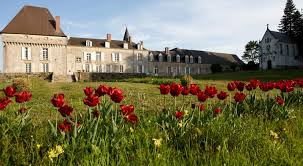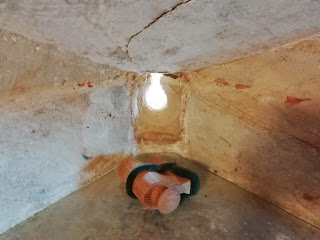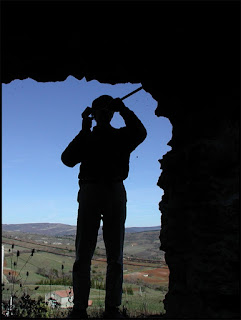Chateau or Castle
 |
| Château de Lalande, kept in the family for centuries |
In English, when we think of the French word château, or the plural châteaux, we think of the fortified castles brought to the British Isles by the Normans. We think of crenellations, moats and stone spiral staircases. That is not what château means in France.
In France châteaux range from medieval forts to a farm estate producing wine. You will find examples of them all in the legendary Loire valley. Fortified royal castles, ‘wedding cake’ palaces, manor houses, hunting lodges inspired by fantasies of antiquity and residences of the vineyards built up by wine producing families. There are examples of each of them also in the first series of ETTC DIY.
Alison and Paul’s Château Brametourte, (http://brametourte-test.com/home/weddings/wedding-service-options/gothic-courtyard) in the Tarn department, is an example of a fortified building that has been little altered over the centuries. Eleventh century Roman vestiges have been identified in their cellars. Above ground the château has been little modified or renovated since the 16th century from when it bears the scars of the religious wars.
 |
| Brametourte's delicately renovated courtyard |
When Fiona Jones stepped inside Château Masgelier (https://www.facebook.com/pg/chateaumasgelier/photos/? ref=page_internal), and saw its medieval stone staircase, she had a ‘coup de foudre’. She wanted dungeons, secret tunnels and a real history and Château Masgelier has it all. As it would, built by the Knights Templar on the site of a older motte and bailey fort in 1174
 |
| Château Masgelier, Built on Motte and Bailey site by the Templars in the 12th century |
The 18th and 19th century mansions boasted a symmetry and elegance adored by the French. In the UK we would call them stately homes. These imposing but uncastle-like Georgian and Victorian facades can be deceptive. Their origins are frequently steeped in history.
The Abbey de la Bussiere (https://www.abayedelabussiere.fr/fr/histoire.html) is half an hour from Dijon and owned by Clive and Tanith Cummings, today a 4 star Hotel with a Michelin starred restaurant. On first impression, the Abbaye de la Bussiere looks like a splendid 18th century hunting lodge. A Marquis built this part of the Abbey after buying it from the state in 1793 following its confiscation from the church during the revolution. Original cellars, a chapel and halls of the Abbey founded in the 11th century by an English Cistertian monk remain intact behind the Neo-gothic veneer of the marquis’ hunting lodge.
 |
| Abaye de la Bussiere, a Neo Gothic hunting lodge with Medieval cellars |
At first glance Phil and Angelina's château at Gorron, Château du Bailleul (https://chateaudubailleul.com/gallery/) has the Hallmark of a 19th century residence built in the 'Empire style' . The country home of a successful bourgeois industrialist. However its walls include vestiges of one of the earliest fortified stone castles in France. Records show that this castle had guests the likes of Richard the Lionheart and Henry II who passed through and spent a night in its Donjon.
 |
| Empire style at Chateau Bailleul |
Château Basmaignee (https://www.basmaignee.com/history/), that belongs to the formidable Pethericks, equidistant between Rennes and Le Mont-Saint-Michel, was built by a 19th century steel tycoon. However the estate has pagan legends that are still remembered.
 |
| Glorious woodland and copses at Chateau Basmaignee |
Château de Lys https://www.chateaudeslys.com/history/, an hour from Dieppe and from Calais, and Château de Perrière (https://www.chateaulaperriere.com/), a Loire Valley château less than an hour East of Tours, would be called manor houses in the United Kingdom. These gorgeous family homes were built as summer residences. Even so, in their day, they would have been productive with agriculturally profitable goings on.
 |
| The turrets at Chateau la Perriere are delightful not defensive |
 |
| Tim and Magreeth's Chateau des Lys |
Below the Loire valley in south west France, fortified castles have been transformed by 18th century and 19th century fashions and social changes to a lesser extent. Since the 17th century, less prosperous than Northern France, in the south castles were viewed more as ruinous and decadent folly. They have even been partially dismantled and the stone used to build new village houses. Many lost their symmetry and have sometimes been abandoned not just for a couple of generations but for centuries. Our Château St Ferriol (http://www.st-ferriol.com/), in the deep south, 45 minutes south of Carcassonne is a good example of this.
 |
| The height of modernity, a cannonier for a musket |
 |
| Ashley and Johnny's Chateau de Lomenie |
Nearly all of the Castles in ETTCDIY have spent great periods abandoned. Stephanie Jarvis’ castle Château de Lalande (http://www.chateaudelalande.com/) is an example of one which has been held on to by the same family for centuries until Stephanie ‘found’ it. Château de Lalande is one hour and a half from Limoges-Bellegarde Airport. Château de Lalande has always had people who have cherished, adapted and added to it since its fortified beginnings. The departing family are grateful that Stephanie has found a way to take care of this building with purpose and love. They return from time to time and invite Stephanie to one of their favourite local restaurants.
Perhaps one of the unifying factors of all these castles is that they are such a lot of hard work. If, to quote Phil Baillie-Smith, you find that” cutting the grass in the summer takes up one day of every week”, you have probably bought yourself a château.
These ruins today stripped of their agricultural wealth and feudal servitude are not for the faint hearted when it comes to rescuing from years of neglect. I like to darkly joke that when James and I bought Château St Ferriol we turned one ruin into three.
As well as the demand for hard work another common thread between these diverse châteaux is the way these buildings first and foremost belong to their place, and the people that live there. The château survives wars, revolutions, royal visits, resident garrisons of soldiers, commerce and now the seductive play thing of idealistic British dreamers and pioneers. Each is only an episode in the life of the château. Being in the château and protecting it, links the 'chatelain' in a profound way to the community. It was put very well by Michael Halpin of Château Jalesnes in our interview “The most important thing is being part of the village. We are guardians. Not even a chapter. We are a paragraph”.
Please note these stories are working notes for the book. Historical or architectural inaccuracies and omissions may be eliminated and corrected in the final published version.

Comments